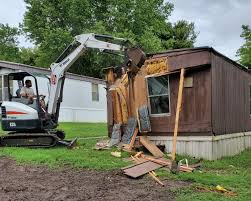
Residential Demolition: Everything You Need to Know
Residential demolition is a process that involves the removal of a building or a portion of it. Demolishing a home can be a complex operation that requires the proper planning, preparation, and execution. While it may seem like a simple process, residential demolition is a complex process that can affect the environment, surrounding structures, and the community as a whole. In this blog post, we will discuss everything you need to know about residential demolition.
Reasons for Residential Demolition
There are several reasons why a homeowner might consider demolishing their residential property. These include:
- The property is in poor condition and requires extensive repairs that are not cost-effective.
- The property is outdated and does not meet the needs or preferences of the homeowner.
- The property is in an area where there is significant development, and the land is more valuable than the building.
- The property has significant structural damage, and it is unsafe to live in.
The Demolition Process
The demolition process involves several steps, including the following:
Pre-demolition planning: This stage involves obtaining permits, hiring a demolition contractor, assessing the site, and developing a demolition plan.
Site preparation: This involves removing any hazardous materials from the site, disconnecting utilities, and preparing the site for demolition.
Demolition: During this phase, the structure is brought down using equipment such as excavators, bulldozers, and cranes.
Removal of debris: After the structure is demolished, the debris is removed and transported to a landfill.
Potential Risks and Environmental Impact
Residential demolition can have several risks and environmental impacts. Some of these include:
Noise pollution: Demolition can create a lot of noise pollution, which can be disruptive to nearby residents.
Air pollution: The demolition process can create dust and debris, which can cause air pollution and pose a health risk.
Asbestos and other hazardous materials: Older homes may contain asbestos, lead paint, or other hazardous materials that require special handling and disposal.
Soil contamination: Demolition can cause soil contamination if hazardous materials are not properly disposed of.
Finding a Demolition Contractor
Finding the right home demolition contractor is essential for ensuring a safe and successful demolition project. Some tips for finding the right demolition contractor include:
- Researching different contractors and checking their credentials and references.
- Asking for a detailed estimate and timeline for the project.
- Checking if the contractor has liability insurance and workers’ compensation insurance.
- Reviewing the contract to ensure everything is included and there are no hidden fees.
Conclusion
Residential demolition is a complex process that requires careful planning, preparation, and execution. It is crucial to work with a reputable demolition contractor and obtain the necessary permits to ensure a safe and successful demolition project. Remember that residential demolition can also have environmental impacts, and it is essential to take steps to mitigate these risks. If you are considering demolishing your residential property, be sure to do your research and understand the potential risks and costs involved.



